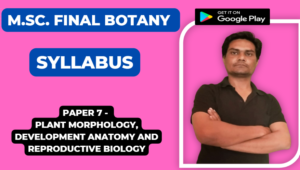![]()
Unit 1
Biotechnology ; Basic concepts, principles and scope.
Plant cell and tissue culture; General introduction, history scope, concept of cellular differentiation, totipotency..
Organogenesis and adventive embryogenesis: fundamental aspects of morphogenesis; somatic embryogenesis and androgenesis mechanisms, techniques and utikity.
Unit 2
Somatic hybridization ; Protoplast isolation fusion and culture hybrid selection and regeneration, possibilities, achievements and limitations of protoplasts research.
Applications of Plant tissue culture; Clonal propagation artificial seed, production of hybrid and somaclones, production of secondary metabolites/natural products, cryopreservation and germplasm storage.
Recombinant DNA technology ; Gene cloning principles and techniques construction of genomic /cDNA libraries, choice of vectors, DNA synthesis and sequencing, polymerase chain reaction, DNA finger printing.
Unit 3
Genetic engineering of Plants; Aims strategies for development of transgenics (with suitable examples), Agrobacterium the natural genetic engineer, T-DNA and transposon mediated gene tagging, chloroplast transformation and its utility, intellectual property rights, possible ecological risks and ethical concerns.
Microbial genetics manipulation ; Bacterial transformation selection of recombinants and transformants, genetic improvement of industrial microbes and nitrogen fixers, fermentation technology.
Unit 4
Genomics and proteomics; Genetic and Physical mapping of genes, molecular markers for introgression of useful traits artificial chromosome, high throughout sequencing genome projects, bioinformatics, functional genomics, microarrays, protein profiling and its significance
Bioactive compounds: Alkaloid antioxidants, flavonoid, proteins and terpenoids.



